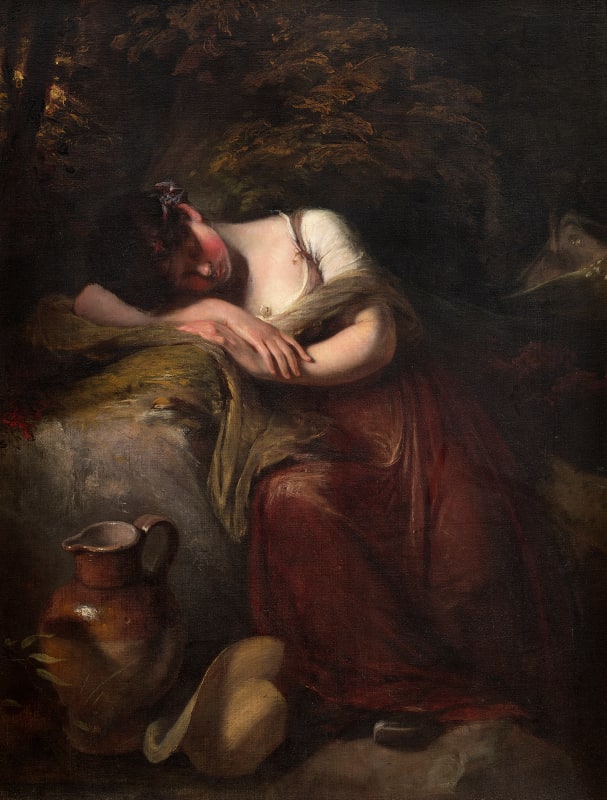Full Biography
The 17th century artist and art collector Sir Peter Lely (originally Pieter van der Faes) was born in Soest, Westphalia, Germany. His father, Johan van der Faes, was stationed as an infantry Captain in the Dutch army and his mother, Abigail van Vliet, was from a wealthy family based in Utrecht. His family owned a number of properties; one of which, In de Leyle, was decorated with the carving of a lily and is said to be the origin of Lely's pseudonym. Having attended The Guild of St Luke, as the pupil of Frans Pietersz de Grebber, Lely gained a reputation as a remarkably adept figure painter and portraitist.
Although the exact date Lely travelled to England is unclear, it is generally accepted that he had settled in London by c. 1643, during English civil war, two years afte the death of the portraitist Anthony van Dyck.
Sir Peter Lely's character and talent dominated the art world of the second half of the seventeenth century in England. Despite sharing the stage with many accomplished painters, the particular brio of his technique and his considerable personal charm guaranteed him the most prestigious patronage. Almost all of consequence in his age sat to him, and it is in his portraits that we form our conception of the cautious solemnity of the 1650s and the scandalous excesses of the years following the Restoration.
The influence and success of Van Dyck amongst the English patrons encouraged Lely to adopted a more Van Dyckian technique in response. This influence however was only really to flourish outwardly following the Restoration in 1660, when Lely's sitters wished to be portrayed with all the flamboyance of their Caroline predecessors, and not the austere worthiness of the hated Cromwellian interregnum.
Sir Peter Lely's character and talent dominated the art world of the second half of the seventeenth century in England.
The 17th century artist and art collector Sir Peter Lely (originally Pieter van der Faes) was born in Soest, Westphalia, Germany. His father, Johan van der Faes, was stationed as an infantry Captain in the Dutch army and his mother, Abigail van Vliet, was from a wealthy family based in Utrecht. His family owned a number of properties; one of which, In de Leyle, was decorated with the carving of a lily and is said to be the origin of Lely's pseudonym. Having attended The Guild of St Luke, as the pupil of Frans Pietersz de Grebber, Lely gained a reputation as a remarkably adept figure painter and portraitist.
Although the exact date Lely travelled to England is unclear, it is generally accepted that he had settled in London by c. 1643, during English civil war, two years after the death of the portraitist Anthony van Dyck.
Sir Peter Lely's character and talent dominated the art world of the second half of the seventeenth century in England. Despite sharing the stage with many accomplished painters, the particular brio of his technique and his considerable personal charm guaranteed him the most prestigious patronage. Almost all of consequence in his age sat to him, and it is in his portraits that we form our conception of the cautious solemnity of the 1650s and the scandalous excesses of the years following the Restoration.
The influence and success of Van Dyck amongst the English patrons encouraged Lely to adopted a more Van Dyckian technique in response. This influence however was only really to flourish outwardly following the Restoration in 1660, when Lely's sitters wished to be portrayed with all the flamboyance of their Caroline predecessors, and not the austere worthiness of the hated Cromwellian interregnum.
The demand for Lely's portraits grew so rapidly that he was forced to change his technique from that seen in this example: pigment was applied more thinly; less ground was used to build up backgrounds; and the pervasive hand of the (albeit accomplished) studio assistant began increasingly to be employed. Remarkably, despite the civil unrest at this time, Lely was able to run an incredibly efficient studio with a prolific output and many assistants.
Despite this busy environment, Lely was highly secretive when it came to his working methods. He rarely allowed assistants to watch him, making exceptions only on very rare occasions for friends such as artist Mary Beale.
Lely also one of the first artists in Britain to collect art; he possessed an impressive collection of Old Masters, ranging from Titian to Veronese. He owned twenty-two portraits by Van Dyck, some of which are alleged to have been bought by Lely through Van Dyck's widow.
Lely died in 1680, at his house in Covent Garden, London although the legacy of his character and talent, which dominated the art world of the second half of the seventeenth century in England, lives on today. Paintings by Lely can be found throughout museums, galleries and private collections globally, including Tate (London), The National Portrait Gallery (London), The Getty Museum (Los Angeles), the Metropolitan Museum of Art (New York) and many more. A number of works for sale by Peter Lely, and works by his studio, are for sale above.

















